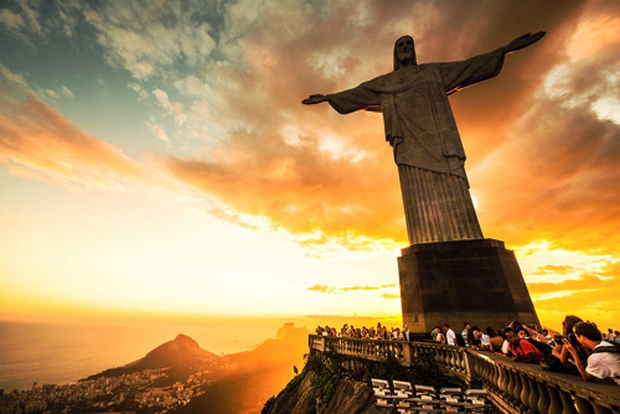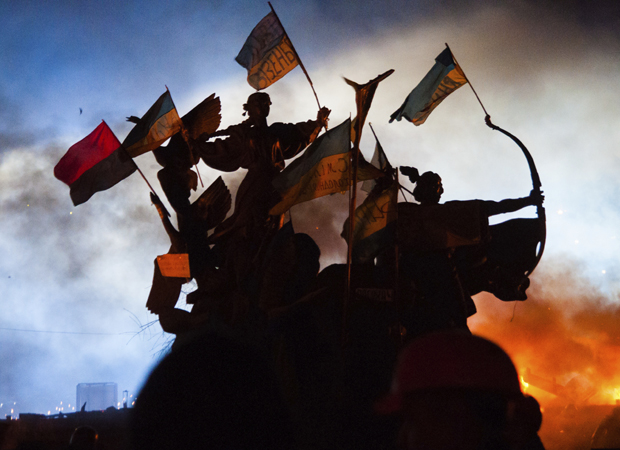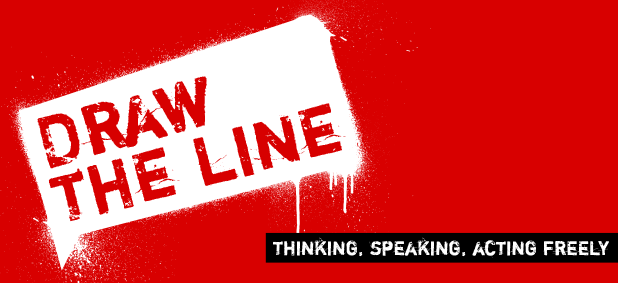12 Jun 2014 | Americas, Brazil, News

(Image: Ksenia Ragozina/Shutterstock)
World Cup time! Hurray! An entire month of football! Rejoice as the pubs stay open late for weirdly timed matches! Gasp at your workmates’ expertise on Iran’s deployment of a false 9! Repeatedly smash yourself in the face with your iPad as you read yet another article by a broadsheet columnist complaining that people don’t pay as much attention to literary fiction as they do to sport!
While the competition officially kicks off tonight, the Brazilians, or, specifically, the archdiocese of Rio have dived in with an early tackle, reportedly threatening to sue Italian broadcaster RAI for an advert showing Rio’s famous Christ The Redeemer statue wearing the Jersey of Italy’s Azzurri.
Suing for what, exactly, is not clear. The church’s lawyer, Rodrigo Grazioli, has been quoted as saying “The Archdiocese is deeply offended. It’s as if Brazilian TV were to make a commercial in which mulatto girls engaged in lewd behaviour with the gladiators of the Colosseum.”
Leaving aside the bizarrely specific and racist mention of “mulatto girls”, and the fact that people involved with churches have to make absolutely everything, ever, about “lewd behaviour”, it’s still not clear what the exact complaint is. Is it the suggestion that the colossal statue might support Italy? That Jesus himself might support Italy? Is this about putting any jersey at all on Jesus, or specifically an Italian one? Is there something specifically blasphemous about suggesting that the Son of God is a catenaccio man?
Or is it something rather more prosaic, such as, say, the church claiming to hold copyright over the image of the statue?
If it is that, as the original O Globo newspaper report suggests, then Grazioli and his clients are being more than a little disingenuous in their outrage. If the issue is simply an objection to commercial usage of the image, than that’s what the complaint should be about.
So why the offended line? Why the suggestion of an insult to religion? Because, put simply, it works. Who wants to be offensive?
In Ireland this week, national broadcaster RTE refused to show a sketch as part of the Savage Eye sketch show. The sketch, now leaked on the web features a group of “wild nuns” ogling a muscular Jesus, in a spoof of Diet Coke ads of old. Comic David McSavage, the man responsible for the skit, has said the broadcaster is afraid of Ireland’s blasphemy laws; RTE says its own guidelines will not allow for “undue offence”.
I’m not even sure that, even if one was a supporter of laws against blasphemy, images of hunky Jesus, or Azzurri Jesus would necessarily count as blasphemous, at least not for Catholics.
On a panel on religious art a few years ago, I found myself simultaneously playing the role of token secularist and token Roman Catholic. The other panelists – art critics and Anglicans – were quite keen on abstraction in religious art. I found myself defending the more visceral, more Roman depictions of Jesus and God on the basis that the entire point of Jesus was his manifestation as human.
To ascribe certain human possibilities to him, such as lust, or even supporting a particular sports team, should not be considered transgressive; indeed I recall, in my youth, our parish priest would often offer up prayers for the local Gaelic football club, suggesting at least the possibility of partisanship. And the very fact that nuns are “brides of Christ” is suggestive of, well…
Catholicism doesn’t really have a problem with idolatry either. Catholics complaining about depictions of Christ do not have the same theological basis as Orthodox Sunni Muslims, who at least can point to some rules on portrayals (which is not to suggest that everyone should follow those rules). Catholics, with our brightly painted statues, sacred medals and all the rest, don’t really have a leg to stand on this one.
These squeals of “offence” are really demands for “respect”, in the Corleone sense. And since the Danish Muhammad cartoons, religions have been in a respect-based arms war. Every time you hear a conservative Christian moan that this or that comic or writer “wouldn’t say that about the Muslims”, remember, they are not praising their own faith’s humility, but condemning its timidity. The archdiocese of Rio is playing a version of this game with its claim to be offended by a Photoshopped football jersey. There’s no reason we should play along.
This article was published on June 12, 2014 at indexoncensorship.org
12 Jun 2014 | Europe and Central Asia, Magazine

Twenty five years ago this autumn the Berlin Wall was pulled down and a wave of euphoria swept not just across that city, but across Europe, and then the world. When, also in 1989, Francis Fukuyama wrote we were seeing the “end of history” it seemed to make sense. His essay suggested not that history was over, but a new era was coming, one in which liberal democracy had defeated authoritarianism and the world would now inevitably become more free.
In the wake of the fall, eastern European nations swapped authoritarian regimes for democratic governments. And people who lived behind that wall were now able to travel more easily, read news that had previously been censored, and listen to music that had been forbidden. Many got the chance to vote in their first free election, with a choice of parties, and even had the option not to vote at all.
Bricks were falling and barriers were coming down as that long line of wire and sentry posts that had divided a continent was dismantled.
A quarter of a century on and the bubble of optimism is deflating. The two world superpowers of the 1980s, the US and Russia, are squaring up again, with presidents Putin and Obama exchanging threats and counter threats. In parts of the former Soviet Union little appears to have changed for the better with attacks on gay people, anti-gay legislation and the introduction of blasphemy and anti-swearing laws. In Belarus and Azerbaijan the hope for freedom still exists, but an atmosphere of fear prevails. Journalists there still live in fear of being beaten up, imprisoned or put under house arrest for writing articles that report problems that dictators would rather not have reported. Internet restrictions stop news being distributed, and samizdat, the opposition’s underground newspapers of the Soviet era, continues to exist in Belarus. Further west of Moscow things are better than they were. Freedom to travel, write and read what you want came with the new era. But there are ominous signs. In Hungary there has been a rise in discrimination against minority groups such as the Roma, swastikas painted on Jewish gravestones, and a rise in support for fascist groups. In Poland there are similar reports of upsurges in extremism and homophobia. That initial post-wall swell of enthusiasm for change has been replaced by cynicism and anxiety.
Across Europe a strand of nasty nationalism is striding into the political arena. And weeks after Russia occupied Crimea, and continues to stand at the redrawn borders of Ukraine, the European landscape looks almost as anxious and divided as it did in the days of presidents Reagan and Brezhnev. Fears about a new Cold War feel well founded. If history teaches us anything, it should teach us to expect situations to repeat themselves, and to learn from the past.
History is certainly playing a part in these cycles. The narratives of hate often use a rewriting of history to make their case. “Those people hated us, so now we can hate them,” argues one set. “They supported the Nazis in the war,” argues one more. “The Jews might have had it bad, but it was just as bad for the non-Jewish Poles,” argues another.
A new memorial to a pro-Nazi leader in Hungary has been erected, and writers with far-right connections are now on the country’s school curriculum. Austerity has given the nasty nationalists an opportunity to tell a new story about Europe. It’s too open; it’s too competitive for jobs; our young people don’t have enough opportunities; it’s all the fault of (a group can be named here). And all this creates distant echoes of German voices in the 1930s. Austerity and high levels of unemployment open up an angry fear of a troubled future where people will have less than they have now, often an excuse for popular support for repressive legislation. Politicians and wannabe politicians are drawing out emotional memories of Russia’s fight against the Nazis; WWII victories; and myths of Russia resplendent in centuries past or Hungary split and defeated, then mixing with nostalgia, a cupful of anger and a return to religiosity, in some cases, to present the case for tighter drawn laws that ban free speech or allow states to clampdown on groups they don’t like.
The past is being rewritten.
So, have the expected gains been as nought? In her article for this issue, Irena Maryniak argues that the dividing line in Europe still exists, but it has now shifted further east, along the eastern border of the Baltic states and down the western border of Belarus. To the east there is a greater expectation of conformity and that the group is greater than the individual. There are fault lines where tensions explode and where the push and pull from decades and where arguments about national identity and geo-political pressures result in sudden uprisings and anger. Meanwhile, Konstanty Gebert, who was a leading Solidarity journalist and continues to work as a writer, charts the public’s disillusionment with the “free” press in Poland. He explores why the newly independent media was not as willing to investigate stories as objectively as it should have done, and how people’s trust in the media has dissolved.
Our three German writers on the post-wall era explore different themes. Crime writer Regula Venske looks at the expectation that Germany would have a cohesive national identity by now, but her exploration through crime novels of the country’s image of itself shows a nation more comfortable with itself as regional rather than national. Matthias Biskupek looks back at theatre and literature censored in the former East Germany; while academic and writer Thomas Rothschild has felt his optimism ebb away. Meanwhile Generation Wall, our panel of under 25-year-olds from eastern Europe, speak to their parents’ generation about the past and talk about their present.
Clearly it’s not all bad news. Those members of Generation Wall are mentally and physically well travelled in a way that the older generation was not able to enjoy. They have experienced a life mostly uncensored. Freedom House’s influential Freedom in the World report shows that the number of countries rated as “free” has swept from 61 to 88, and four more than 1989 are rated “partly free”.
And as this year’s Eurovision Song Contest showed there are protests across Europe at the heavy handed tactics of Russian authorities, and at their attitudes to minorities. While a Eurovision audience booing at the Russian contestants or Russia’s neighbours reducing their traditional 12 votes won’t have a long-term effect, it is a sign of an airing of opinions from traditional Russian allies. Bloc voting, so long a tradition in Eurovision, appeared to be breaking down. The end of history has not happened, but learning from the past should never go away.
This article was published in the Summer 2014 issue of Index on Censorship magazine.
12 Jun 2014 | Draw the Line, News

To celebrate the start of the World Cup 2014, Index is kicking off its new debating section: Draw the Line. We want to hear your thoughts on key free expression issues of the day and this is your opportunity to share them.
Each month, our Youth Advisory Board will choose a free expression topic and encourage readers to respond to the issues it raises. This month, we are asking ‘Good sports: Which free-speech offending countries should we blow the whistle on?’ You can read more here about why Brazil 2014 is not the only sporting event to ever cause controversy in the free speech arena and then get involved by posting your responses on social media using the hashtag #IndexDrawtheLine. Check back on the page to see who is saying what and get debating.
Draw the Line also features pieces from our Young Writers/Artists programme as well as relevant features from our award winning quarterly magazine. For more information on our youth work, contact [email protected]



